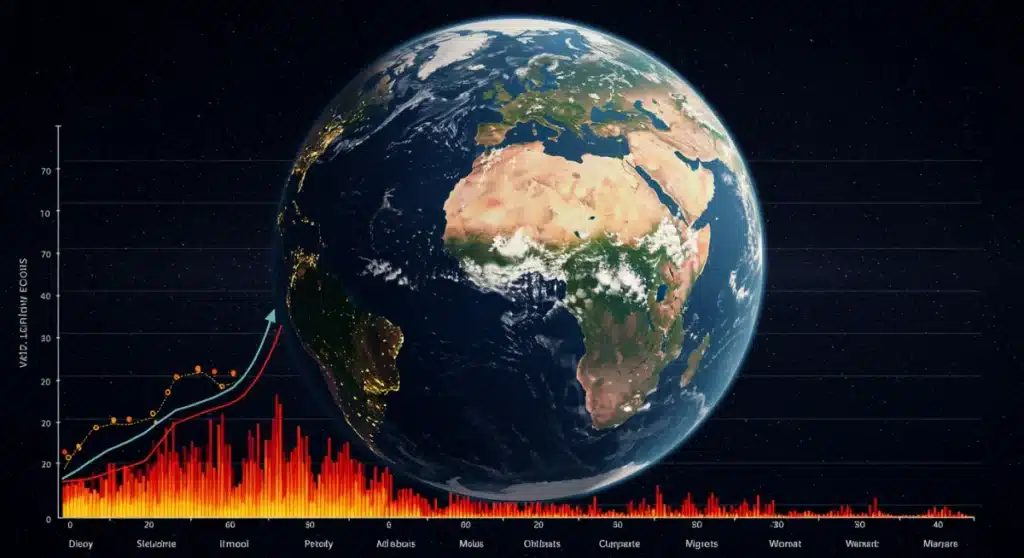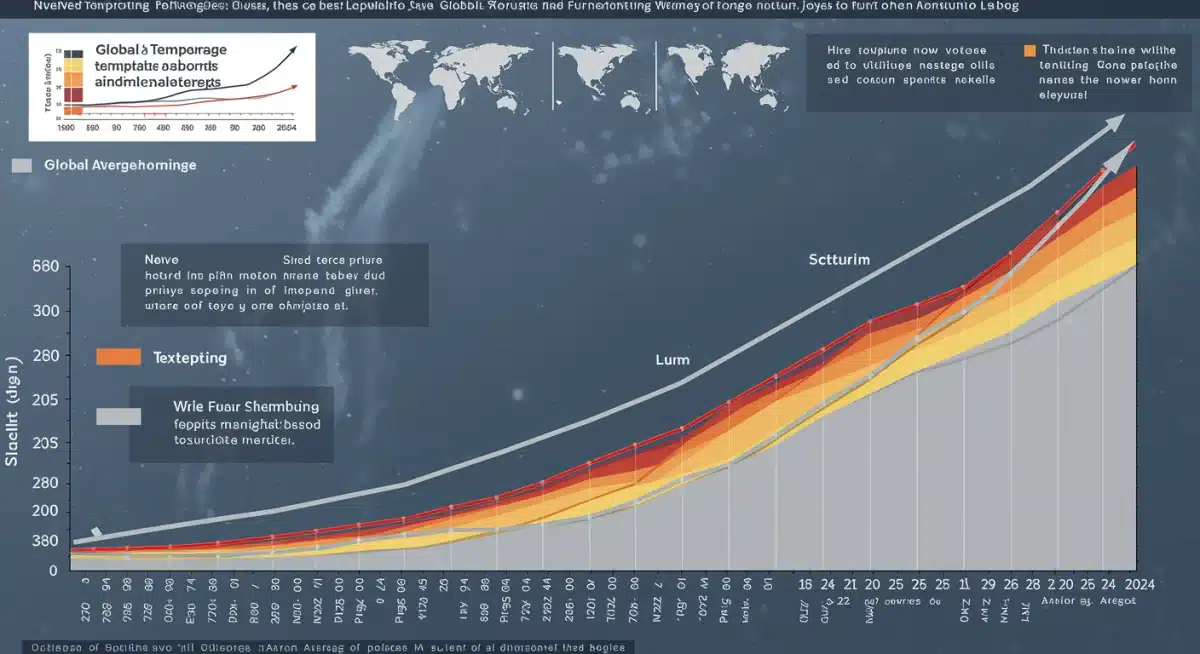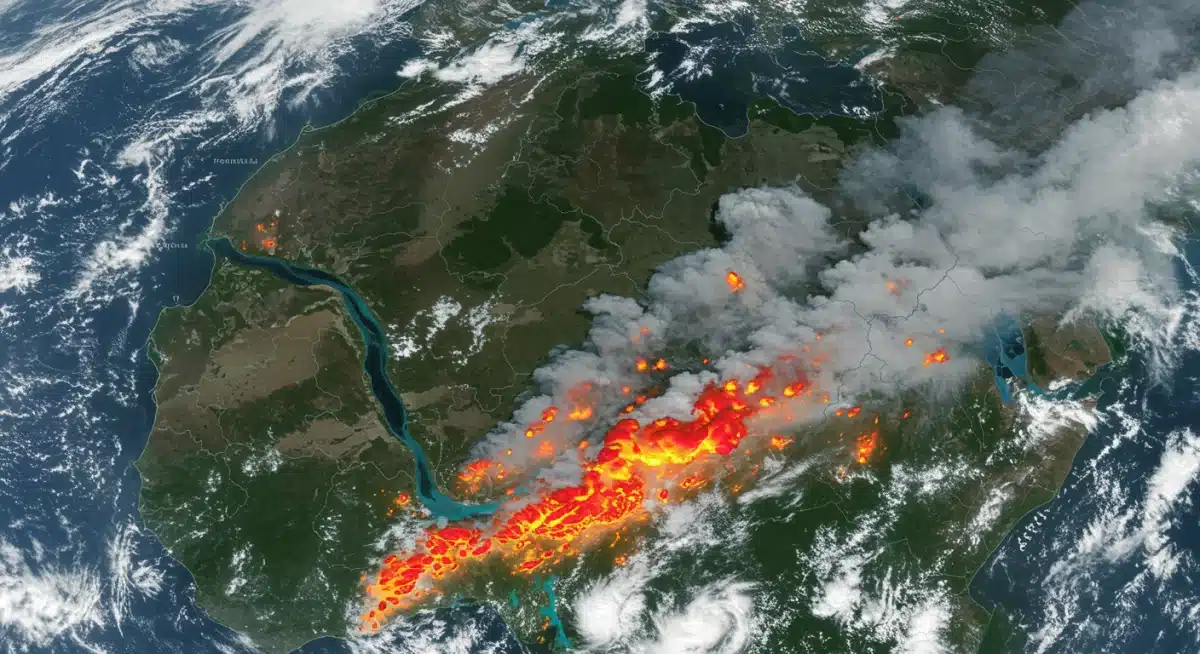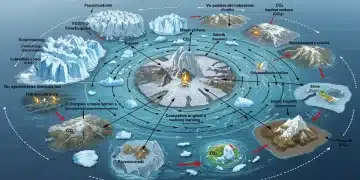Climate Data 2024-2025: Global Temperature Records & Outlook

Latest climate data reveals unprecedented 2024 global temperature records and projects continued warming into 2025, highlighting critical implications for environmental stability and human societies worldwide, demanding immediate attention and action.
The latest climate data: a deep dive into the 2024 global temperature records and 2025 outlook is shaping today’s agenda, with new details emerging from leading scientific institutions worldwide. This update prioritizes what has changed, why it matters, and what to watch next, presenting a clear and factual account of our planet’s warming trajectory.
Unprecedented Warming: The 2024 Global Temperature Records
2024 has already cemented its place in climate history, with preliminary data indicating it could be one of the warmest years on record, potentially surpassing previous benchmarks. Scientists are meticulously analyzing temperature anomalies across land and ocean surfaces, revealing a consistent and alarming upward trend that aligns with long-term climate change projections.
The global average temperature for 2024 has shown significant deviations from pre-industrial levels, signaling an accelerated pace of warming. This surge is not merely an incremental change but represents a clear departure from historical norms, prompting urgent calls for enhanced mitigation and adaptation strategies. The data underscores the critical need to understand the underlying drivers and their cascading effects on ecosystems and human populations.
Key Findings from 2024 Data
- Record-breaking heatwaves: Numerous regions experienced heatwaves of unprecedented intensity and duration, leading to severe public health warnings and infrastructure strain.
- Ocean heat content: The world’s oceans absorbed a significant amount of excess heat, contributing to marine heatwaves, coral bleaching, and disruptions in marine ecosystems.
- Arctic and Antarctic ice loss: Both polar regions continued to witness substantial ice mass loss, further contributing to global sea-level rise and impacting global weather patterns.
The compilation of these records provides an irrefutable body of evidence regarding the ongoing climate crisis. Understanding these 2024 global temperature records is essential for policymakers and communities to prepare for future climate impacts.
The Science Behind the Surge: Drivers of 2024’s Heat
The pronounced warmth observed in 2024 is the result of a complex interplay of natural climate variability and anthropogenic factors. While natural phenomena like El Niño can temporarily amplify global temperatures, the overriding driver remains the continued accumulation of greenhouse gases in the atmosphere from human activities. This scientific consensus is supported by extensive research and modeling.
Atmospheric carbon dioxide concentrations reached new highs in 2024, maintaining the radiative forcing that traps heat within the Earth’s system. This persistent increase in greenhouse gas emissions continues to push global temperatures upwards, making each subsequent year potentially warmer than the last. The scientific community emphasizes that this trend is predictable and directly linked to human industrial and energy consumption patterns.
Contributing Factors to 2024’s Warming
- Persistent greenhouse gas emissions: Carbon dioxide, methane, and nitrous oxide levels continued their upward trajectory, primarily from fossil fuel combustion, industrial processes, and agriculture.
- El Niño influence: The lingering effects of a strong El Niño event contributed to warmer surface temperatures, particularly in the Pacific Ocean, which has a global ripple effect on weather patterns.
- Reduced aerosol pollution: While beneficial for air quality, some reductions in aerosol emissions (which have a cooling effect) may have contributed to a slight increase in absorbed solar radiation.
These combined factors underscore the urgency of addressing the root causes of climate change. The latest climate data, including the 2024 global temperature records, serves as a stark reminder of the consequences of inaction.

Looking Ahead: The 2025 Climate Outlook
Projections for 2025 indicate a high probability of continued warming, with scientists forecasting another year of elevated global temperatures. Climate models, informed by the 2024 global temperature records and current emission trajectories, suggest that the trend of hotter years is unlikely to abate in the immediate future. This outlook has significant implications for long-term climate planning and immediate preparedness.
The 2025 outlook anticipates a potential transition from El Niño to La Niña conditions, which typically has a cooling effect. However, the underlying warming trend driven by greenhouse gases is expected to largely offset any natural cooling, meaning 2025 is still likely to rank among the warmest years. This highlights that natural variability now acts on a fundamentally warmer planet.
Projections for 2025
- Continued temperature anomalies: Global average temperatures are expected to remain significantly above pre-industrial levels, potentially challenging or surpassing previous records.
- Increased frequency of extreme events: Forecasts suggest a higher likelihood of extreme weather events, including intense heatwaves, prolonged droughts, and more severe precipitation events in various regions.
- Persistent sea-level rise: Ocean thermal expansion and continued ice melt are projected to contribute to an ongoing rise in global sea levels, impacting coastal communities.
The 2025 climate outlook reinforces the need for robust climate action and adaptation measures to build resilience against these anticipated impacts.
Regional Impacts: A Global Story with Local Consequences
While the 2024 global temperature records paint a worldwide picture, the impacts are acutely felt at regional and local levels. From agricultural shifts in the American Midwest to increased wildfire risks in the Western United States, and altered precipitation patterns across the globe, the consequences of a warming planet are diverse and far-reaching. These regional effects often disproportionately affect vulnerable communities.
In the United States, for instance, hotter summers are stressing power grids, increasing demand for air conditioning, and exacerbating urban heat island effects. Agricultural regions face challenges with crop yields due to unpredictable weather and prolonged droughts. Coastal areas are confronting accelerated erosion and increased flood risks from rising sea levels and more intense storm surges, as evidenced by recent scientific reports.
Specific Regional Impacts
- North America: Increased frequency of extreme heat events, prolonged wildfire seasons in the West, and altered agricultural growing seasons.
- Europe: More intense and frequent heatwaves, leading to drought conditions and stress on water resources and public health.
- Asia: Intensified monsoon patterns, leading to severe flooding in some areas and water scarcity in others, impacting millions.
- Africa: Exacerbated water stress and food insecurity due to shifting rainfall patterns and prolonged dry spells in already vulnerable regions.
Understanding these localized effects is crucial for developing targeted and effective climate adaptation strategies. The latest climate data, including the stark 2024 global temperature records, makes these regional vulnerabilities undeniable.

Societal and Economic Repercussions of Rising Temperatures
The implications of the 2024 global temperature records and the 2025 outlook extend far beyond environmental changes, permeating societal structures and economic stability. From public health crises exacerbated by heat stress and vector-borne diseases to disruptions in global supply chains and increased insurance costs, the economic burden of climate change is rapidly escalating. These challenges demand comprehensive national and international responses.
Healthcare systems are increasingly strained by heat-related illnesses and the spread of diseases into new geographic regions. Economic sectors like agriculture, tourism, and fisheries face direct threats from changing climate patterns, leading to job losses and reduced productivity. The financial sector is also grappling with climate-related risks, assessing the vulnerability of assets and infrastructure to extreme weather events and long-term environmental shifts, as reported by financial analysts and climate economists.
Economic and Social Challenges
- Public health crises: Increased mortality and morbidity from heatwaves, respiratory issues from wildfires, and expanded ranges for disease vectors.
- Food and water insecurity: Disruptions to agricultural systems and water cycles threaten global food supplies and access to clean drinking water.
- Infrastructure damage: Extreme weather events cause billions in damages to transportation, energy, and housing infrastructure, requiring costly repairs and upgrades.
- Migration and displacement: Climate-induced disasters and resource scarcity can lead to internal and international migration, creating humanitarian challenges.
Addressing these societal and economic repercussions requires proactive planning and significant investment in resilient infrastructure and equitable adaptation measures. The latest climate data serves as a critical input for these strategic decisions.
Pathways to Resilience: Mitigation and Adaptation Strategies
In the face of the stark 2024 global temperature records and the challenging 2025 outlook, concerted efforts in both climate change mitigation and adaptation are more critical than ever. Mitigation focuses on reducing greenhouse gas emissions to slow down global warming, while adaptation involves adjusting to the current and future effects of climate change. Both are indispensable for securing a sustainable future.
Governments, industries, and individuals are increasingly recognizing the imperative to transition to cleaner energy sources, improve energy efficiency, and protect natural carbon sinks. Simultaneously, communities are implementing adaptation measures such as developing early warning systems for extreme weather, building climate-resilient infrastructure, and implementing water conservation strategies. International cooperation and technological innovation play vital roles in accelerating these efforts, as highlighted by recent UN climate reports.
Key Strategies for Action
- Accelerated decarbonization: Rapid transition from fossil fuels to renewable energy sources across all sectors, including power generation, transportation, and industry.
- Enhanced energy efficiency: Implementing policies and technologies that reduce energy consumption in buildings, manufacturing, and daily life.
- Nature-based solutions: Protecting and restoring ecosystems like forests, wetlands, and oceans that absorb carbon and provide natural defenses against climate impacts.
- Investment in resilient infrastructure: Designing and constructing infrastructure capable of withstanding extreme weather events and changing environmental conditions.
The dual approach of mitigation and adaptation offers the most comprehensive pathway to address the challenges presented by the latest climate data and build a more resilient world. This proactive stance is essential for navigating the future impacts of global temperature records.
| Key Finding | Brief Description |
|---|---|
| 2024 Temperature Records | Likely one of the warmest years, with unprecedented heatwaves and ocean warming. |
| Drivers of Warming | Primarily human-induced greenhouse gas emissions, amplified by natural phenomena like El Niño. |
| 2025 Outlook | Continued high temperatures and increased likelihood of extreme weather events are projected. |
| Impact & Action | Severe societal and economic repercussions necessitate urgent mitigation and adaptation strategies. |
Frequently Asked Questions About Global Temperature Records
Preliminary data for 2024 shows significant temperature anomalies across land and ocean, with numerous regions experiencing unprecedented heatwaves. This consistent warming trend, analyzed by climate scientists, places it among the warmest years on record, potentially surpassing previous benchmarks due to persistent greenhouse gas emissions.
El Niño events typically warm the planet by releasing heat from the Pacific Ocean into the atmosphere, while La Niña events tend to have a cooling effect. These natural cycles can temporarily amplify or dampen human-induced warming, but the long-term trend of rising global temperatures remains dominated by greenhouse gas emissions.
Climate change impacts vary significantly by region. Some areas experience more intense heatwaves and droughts, while others face increased flooding from heavy rainfall or sea-level rise. These localized effects depend on geographic factors, existing vulnerabilities, and specific climate patterns, requiring tailored adaptation strategies for each region.
Rising temperatures lead to substantial economic costs, including damages from extreme weather, reduced agricultural yields, increased healthcare expenses due to heat-related illnesses, and disruptions to supply chains. These impacts can strain national budgets, increase insurance premiums, and affect various industries, posing significant challenges to global economic stability.
Addressing the 2025 climate outlook requires accelerating decarbonization by transitioning to renewable energy, enhancing energy efficiency, and implementing nature-based solutions. Additionally, investing in climate-resilient infrastructure and developing robust adaptation strategies are crucial steps to mitigate impacts and build resilience against future temperature increases and extreme weather events.
What This Means for Our Future
The record-breaking 2024 global temperatures and the concerning 2025 outlook reveal an unambiguous truth—our planet is warming at a pace that challenges the limits of human and ecological resilience. These findings are not isolated data points but the cumulative result of decades of unsustainable practices and delayed action. Climate change now intersects with every facet of human life, from food and water security to economic stability and public health, demanding a unified global response.
The path forward must prioritize both mitigation and adaptation—reducing emissions through clean energy transitions while strengthening infrastructure to withstand inevitable climatic shifts. Governments, industries, and individuals all play pivotal roles in closing the gap between awareness and measurable action. Collaboration across borders and sectors will define whether we stabilize our planet’s trajectory or accelerate toward irreversible tipping points.
For a deeper understanding of the science behind these alarming trends, the NOAA Climate.gov analysis of global temperature data offers a clear, evidence-based overview of how rising heat levels are reshaping our world. The urgency is undeniable: the choices we make in this decade will determine not just the climate we inherit—but the one we create for generations to come.





